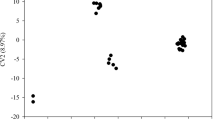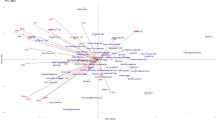Abstract
The stability of various descriptive characters was studied over a 5-year period in 14 lines of quinoa (Chenopodium quinoa Willd.) to determine the most appropriate time in a breeding programme when selection for these characters could be performed, and which lines could serve as potential parents. Various measures of stability were employed to analyse these data, including those proposed by Francis and Kannenberg (1978) and Lin and Binns (1988), appropriately modified for the purpose of this investigation. From these results it was concluded that selection for height, inflorescence size and developmental stage could be satisfactorily performed at an early stage of the breeding programme. For saponin content, however, the measuring techniques available were too insensitive to enable a recommendation to be made. Potential parents were identified in this material for use in the development of varieties suitable for North European conditions.
Similar content being viewed by others
References
Becker HC (1981a) Biometrical and empirical relations between different concepts of phenotypic stability. In: Gallais A (ed) Quantitative genetics and breeding methods. INRA, Versailles, pp 307–314
Becker HC (1981b) Correlations among some statical measures of phenotypic stability. Euphytica 30:835–840
Becker HC, Léon J (1988) Stability analysis in plant breeding. Plant Breed 101:1–23
Breese EL (1969) The measurement and significance of genotypeenvironment interactions in grasses. Heredity 24:27–44
Bucio Alanis L (1966) Environmental and genotype-environmental components of variability. I: inbred lines. Heredity 21: 387–397
Eberhart SA, Russell WA (1966) Stability parameters for comparing varieties. Crop Sci 6:36–40
Fatunala T, Frey KJ (1976) Repeatability of regression stability indexes for grain yield of oats (Avena sativa L.). Euphytica 25:21–28
Finlay KW, Wilkinson GN (1963) The analysis of adaptation in a plant-breeding programme. Aust J Agric Res 14:742–754
Francis TR, Kannenberg LW (1978) Yield stability studies in shortseason maize. I: A descriptive method for grouping genotypes. Can J Plant Sci 58:1029–1034
Helgadóttir A, Kristjansdóttir K (1991) Simple approach to the analysis of G x E interaction in a multi-locational spaced plant trial with timothy. Euphytica 54:64–73
Hill J (1975) Genotype-environment interactions — a challenge for plant breeding. J Agric Sci 85:477–493
Jacobsen S-E (1992) Anti-nutritional compounds in fodder crops. In: Proc 13th Nordic Postgraduate Course. Helsinki, Finland, pp 272/2-299
Jacobsen S-E, Stølen O (1993) Quinoa —morphology and phenology and prospects for its production as a new crop in Europe. Eur J Agron 2:19–29
Jinks JL, Pooni HS (1981) Comperative results of selection in the early and late stages of an inbreeding programme. Heredity 46:1–7
Kozio MJ (1990) Afrosimetric estimation of threshold saponin concentration for bitterness in quinoa (Chenopodium quinoa Willd). J Sci Food Agric 54:211–219
Lin CS, Binns MR (1988) A superiority measure of cultivar performance for cultivar x location data. Can J Plant Sci 68:193–198
Lin CS, Binns MR, Lefkovitch LP (1986) Stability analysis: where do we stand? Crop Sci 26:894–900.
Littell RC, Freund RJ, Spector PC (1991) SAS system for linear models. SAS series in statistical applications. SAS Institute, Cary, N.C.
Pinthus MJ (1973) Estimate of genotypic value: a proposed method. Euphytica 22:121–123
Price KR, Johnson IT, Fenwick GR (1987) The chemistry and biological significance of saponins in foods and feedingstuffs. CRC Crit Rev Food Sci Nutr 26:27–135
Risi J, Galwey NW (1989) The pattern of genetic diversity in the Andean grain crop quinoa. I: associations between characteristics. Euphytica 41:147–162
SAS/STAT (1988) SAS/STAT user's guide. Release 6.03 edition. SAS Institute, Cary, N.C.
Witcombe JR (1988) Estimates of stability for comparing varieties. Euphytica 39:11–18
Yates F, Cochran WG (1938) The analysis of groups of experiments. J Agric Sci 28:556–580
Author information
Authors and Affiliations
Additional information
Communicated by P. M. A. Tigerstedt
Rights and permissions
About this article
Cite this article
Jacobsen, S.E., Hill, J. & Stølen, O. Stability of quantitative traits in quinoa (Chenopodium quinoa). Theoret. Appl. Genetics 93, 110–116 (1996). https://doi.org/10.1007/BF00225735
Received:
Accepted:
Issue Date:
DOI: https://doi.org/10.1007/BF00225735




